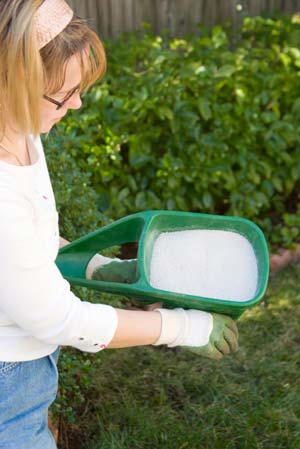
As the weather gets warmer, many a Texan’s thoughts turn to sprucing up
that lawn, landscape or garden. Unfortunately, in an effort to “green up,”
many people actually hurt the environment by going overboard when they
apply fertilizer. People often think if a little fertilizer is good, a lot is great.
But that’s not the case.
When it comes to feeding your lawn one should always follow the
manufacturer’s instructions on how much fertilizer to apply, and when. Too
much fertilizer can hurt a lawn and other plants and the excess can wash
into storm drains. And this is especially an issue for those who live along
lakes, streams or other bodies of water that receive runoff.
Fertilizer can cause real problems in bodies of water. The added nutrients
can promote aquatic plant growth that can be a nuisance to boaters and
others who love our lakes. The added nutrients can also feed golden algae
that have been linked to the deaths of large numbers of fish recently at
Lake Granbury, and previously at countless spots around Texas and the
nation.
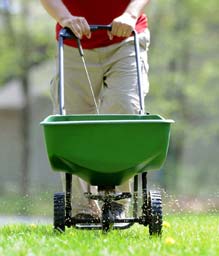
In addition to following the manufacturer’s instructions, here are some
other tips about using fertilizers and caring for your lawns while
protecting our lakes.
- Test your soil before fertilizing. You may not need it.
- Do not apply fertilizers or pesticides before or during rain.
- Avoid using fertilizers near surface water.
-
Plant native vegetation to reduce the need for water, fertilizers
and pesticides.
-
Use organic, no-phosphate or slow-release fertilizers as much
as possible.
-
Plant vegetation around driveways, shorelines and on slopes
since they aid in absorbing and filtering pollutants.
-
Be sure to keep grass clippings out of the lake, storm drains and streets. Grass becomes high in
nutrients as they decompose.
To learn more about fertilizing your lawn, click here.
LAWN FERTILIZATION IN TEXAS
R. L. Duble, James A. McAfee, and A. C. Novosad
Extension Turfgrass Specialists
Lawn quality is generally measured in terms of color, density and uniformity. Cultural practices,
particularly fertilization, largely determine lawn quality. A fertilization program should include
timely fertilizer applications in amounts and formulations that meet the requirements of your
lawn. Excessive nitrogen applications stimulate production of leaves and stems and increase the
mowing requirements. Higher water requirements, increased thatch and increased susceptibility
to insects and diseases also results from excessive application of nitrogen. Poor timing of
fertilizer applications, such as mid-summer and early fall applications of soluble nitrogen, also
increases the likelihood of chinch bug and brown patch problems in St. Augustine lawns.
Fertilizer Requirements
The amount and formulation of fertilizer to apply depends on soil test results, grass species,
environmental conditions and mowing practices.
Soil tests provide information on the availability of major fertilizer nutrients. Some soils contain
phosphorus and/or potassium in amounts adequate for the maintenance of turfgrasses. Additional
applications of these nutrients through fertilization would not improve the quality of the lawn.
On the other hand, grass growing on soils deficient in one or more of these nutrients will respond
to fertilizers containing these nutrients. Soil tests also suggest the need for lime or other
amendments to correct soil acidity, soil salinity or alkali soil conditions.
Grass species differ in fertilizer requirements in the following order:
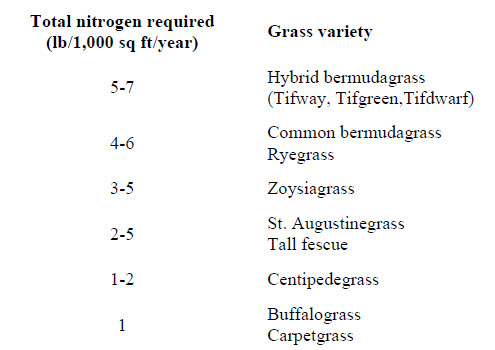
Environmental conditions such as shade, soil type and rainfall also influence fertilization
requirements. Moderately or heavily shaded areas should not be fertilized as much as areas in
full sunlight. Grass growing in shade is more succulent and has a weaker root system than grass
growing in full sunlight. Fertilizer tends to make the grass more succulent and increases its
susceptibility to disease, drought and other
stresses. Nitrogen fertilizer also stimulate
leaf growth at the expense of the root
system. St. Augustine growing in moderate
to heavy shade should be fertilized in the
spring and fall only, at a rate of 1 1/2 pounds
of nitrogen per 1,000 square feet.
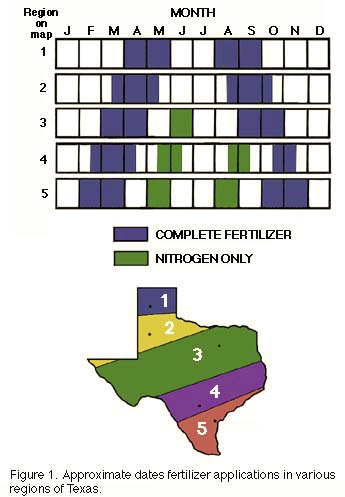
Turfgrasses growing in sandy soils require
more frequent applications of nitrogen than
those growing on clay soils.
Lawns in areas subject to high rainfall
require more total pounds of nitrogen per
year (the higher numbers in the above table)
than lawns grown under dry conditions (the
lower numbers in the table). Thus, St.
Augustine lawns in East Texas may require
4 to 5 pounds of nitrogen compared to 2 to 3
pounds in Southwest Texas.
Mowing practices, such as regular removal
of grass clippings, also influence fertilizer
requirements. Grass clippings contain 3 to 4
percent nitrogen on a dry weight basis,
which is recycled through the soil if grass
clippings are not removed. Regular removal
of grass clippings will add at least one fertilizer application annually to lawn requirements.
Fertilizer Applications
Timing and distribution of fertilizer applications, as well as rate of application, are important
considerations in a lawn fertilization program. Timing applications to corresponds to grass
requirements rather than to the convenience of the homeowner can reduce maintenance problems
(figure 1). Generally, spring and fall fertilizer applications are adequate for St. Augustine lawns.
(Refer to map and calendar for approximate dates). Figure 1. Approximate dates for fertilizer
applications in various regions of Texas.
In early spring there is usually enough residual nitrogen to maintain grass through several
mowings. The first application of fertilizer should be made after the second or third mowing.
If the lawn appears vigorous and healthy at that time, delay the first application until May. In the
absence of soil test information, apply a fertilizer with a 3-1-2 or 2-1-1 ratio at a rate equivalent
to 1 pound of nitrogen per 1,000 square feet.
Bermudagrass lawns require supplemental applications of nitrogen at 45- to 60-day intervals
between spring and fall fertilizations. These applications should not exceed 1 pound of nitrogen
per 1,000 square feet per application. .Occasionally, St. Augustine grass may need a
supplemental application of nitrogen to enhance color during the summer. Use organic or slow release
nitrogen sources on lawns during the summer. Summer fertilization of St. Augustine
grass growing in moderate shade should be avoided because of increased disease activity.
St. Augustine lawns may require periodic applications of iron sulfate or iron chelate to prevent
iron chlorosis. A foliar application of iron sulfate at a rate of 6 to 8 ounces per 1,000 square feet
effectively eliminates the symptoms of iron chlorosis. These applications may be needed several
times during the growing season.
Iron chelates should be applied according to the manufacturer's directions. (Refer to publication
L-435.)
Fertilizers can be distributed with a broadcast (cyclone) or drop-type spreader. Uniform
distribution is essential to prevent light and dark streaks across the lawn. For better distribution,
divide the fertilizer to be applied into two equal lots. Apply one lot lengthwise and the other
crosswise over the lawn (figure 2).
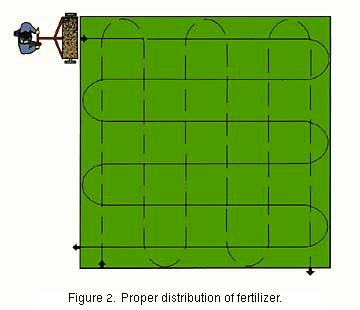
Fall Fertilization
Fall fertilization is the key to prolonging fall color and promoting early springs recovery of
lawns. It also helps to produce a dense turf which resists winter weeds. Fertilizers used in the fall
should be high in nitrogen and potassium and low in phosphorus. A 2-1-2, 3-1-2 or 4-1-2
analysis is preferred over a balanced fertilizer such as a 12-12-12 for fall application. Grass
fertilized in the fall with nitrogen and potassium have shown greater survival during winter
months and faster spring recovery than grasses fertilized with high phosphorus materials in the
fall.
Avoid using straight soluble nitrogen fertilizers such as ammonium sulfate or urea during late
fall because they increase the susceptibility to disease and winterkill.
Make fall applications in September for Regions 1, 2 and 3 (see map) and in October for Regions
4 and 5. Application rates should not exceed 2 pounds of nitrogen per 1,000 square feet.
Type of Fertilizer
Choice of the type and grade of fertilizer material to use depends on soil test recommendations.
Table 1 shows some analysis, ratios and equivalent applications rates of various fertilizers. In
every fertilizer analysis (such as 12-4 8), the first number represents the percent nitrogen (N), the
second number represents the percent phosphorus (P2O5) and the third number represents the
percent potassium (K2O).
Table 1. Nutrient content and equivalent rates of application of some commercial fertilizers.
A complete fertilizer can be used in accordance with soil test results for the spring and fall
applications. Additional nitrogen needed between the fall and spring applications for complete
fertilizer can be supplied from one of several sources, as shown in table 2. Slowly available
sources of nitrogen, such as urea-formaldehyde, IBDU, processed sewage sludge or cottonseed
meal, are more desirable for summer applications of nitrogen than soluble sources such as
ammonium nitrate, urea or ammonium sulfate. Slow-release and organic fertilizers usually cost
more, but they are available to the grass over a longer period of time and help avoid the
excessive growth produced by soluble nitrogen fertilizers. Soluble nitrogen sources should be
applied in small amounts and more frequently than slowly soluble or slow-release types. Also,
soluble nitrogen fertilizers are more likely to burn the grass than slow-release nitrogen fertilizers.
Table 2. Percent nitrogen in various nitrogen sources, and recommended rates of application for lawns.
Educational programs conducted by the Texas Agricultural Extension Service serve people of all ages without
regard to race, color, sex, disability, religion, age or national origin.
Issued in furtherance of Cooperative Extension Work in Agriculture and Home Economics, Acts of Congress of
May 8,1914, as amended, and June 30, 1914, in cooperation with the United States Department of Agriculture, Zerle
L. Carpenter, Director, Texas Agricultural Extension Service, The Texas A&M University System.
Hypertext markup by Tammy Kohlleppel and Dan Lineberger. http://aggiehorticulture.tamu.edu/extension/ornamentals/lawnfert/lawnfert.html